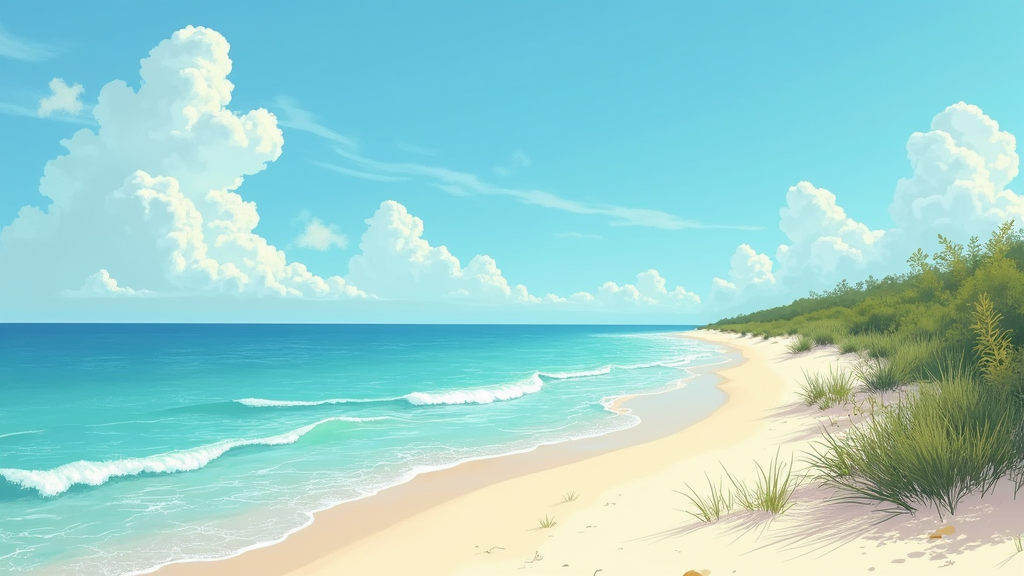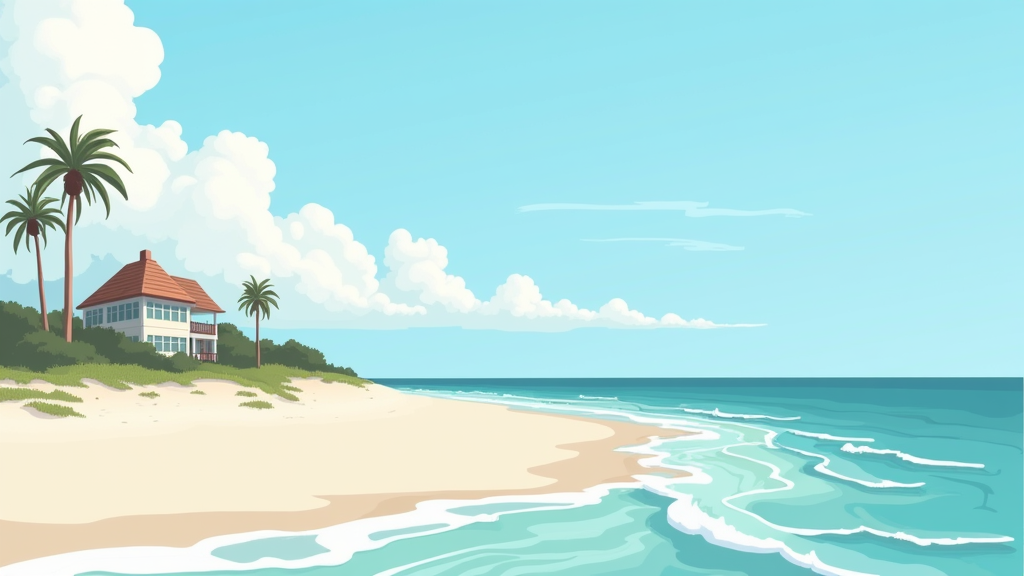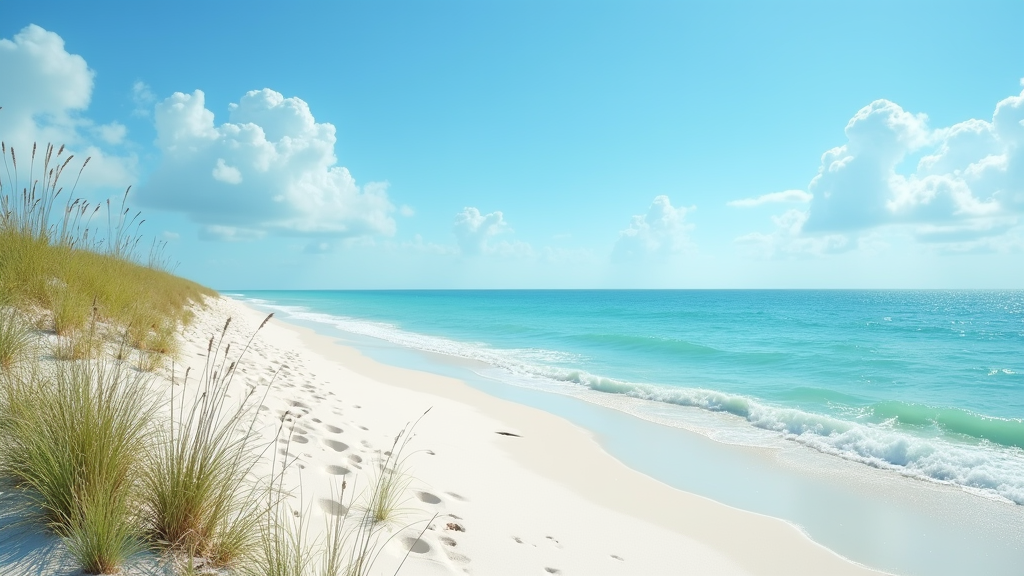Table of Contents
- Exploring the Panhandle of Florida Beaches: An Outline
- Exploring the Panhandle of Florida Beaches Outline
- Defining Emerald Coast and Quartz Sand Beaches
- Understanding Beach Safety and Environmental Care
- Identifying Essential White Sand and Clear Water
- Evaluating Water, Sand Quality and Accessibility
- Considering Amenities, Activities, and Nearby Attractions
- Recognizing Variations in Beach Type and Location
- Detailed Guide to Florida Panhandle Beaches Outline
Exploring the Panhandle of Florida Beaches: An Outline

The Allure of Panhandle Florida’s Pristine Beaches
The Florida Panhandle is home to approximately 150 miles of stunning coastline. Renowned for its dazzling snow-white quartz sand and crystal-clear emerald waters, these beaches offer an unparalleled coastal experience. While the water clarity can fluctuate depending on wind and wave conditions, the Panhandle consistently delivers breathtaking views and invites exploration.
The importance of these beaches cannot be overstated. They provide a diverse range of recreational activities, from swimming and sunbathing to fishing and watersports, and contribute significantly to the region’s economy through tourism. The scenic beauty alone makes the Panhandle a must-visit destination for both tourists and locals alike.
Historical Significance of Panhandle Beach Development
For decades, the beaches of the Florida Panhandle have served as recreational havens, evolving alongside the growth of tourism. Over time, infrastructure has been developed to support the influx of visitors, including hotels, restaurants, and attractions. This evolution has shaped the character of the coastal communities and contributed to their economic vitality.
More recently, there has been an increased emphasis on conservation efforts and the promotion of eco-tourism. The region has also faced challenges, such as recovering from devastating hurricanes like Hurricane Michael in 2018, which have highlighted the need for resilient coastal management strategies.
Understanding the Panhandle Beaches Outline: Key Takeaways
This outline will help you understand the unique features that define Panhandle beaches, including the composition of the sand, the characteristics of the water, and the wide array of activities available. By exploring these core concepts, you’ll gain a deeper appreciation for what makes this coastline so special.
Beyond simply understanding the beaches, this guide will provide practical applications for planning your perfect beach vacation. Whether you’re looking to choose the right beach for specific activities, such as snorkeling or surfing, or seeking to understand local regulations regarding beach access and conservation, this outline will equip you with the knowledge you need to make the most of your time on the Panhandle.
Exploring the Panhandle of Florida Beaches Outline
Defining Emerald Coast and Quartz Sand Beaches
The Florida Panhandle, often called the Emerald Coast, boasts stunning beaches characterized by their unique features. The term “Emerald Coast” refers to the region’s distinctive green-tinted waters, a result of specific algae and water conditions. Another defining characteristic is the pristine white sand, primarily composed of quartz. This quartz sand is responsible for the bright, reflective beaches that attract visitors from around the globe.
Understanding Beach Safety and Environmental Care
Before enjoying the beautiful Panhandle beaches, it’s crucial to understand key safety principles. Awareness of rip currents is paramount, as these strong currents can quickly pull swimmers away from shore. Respect for marine life is also essential, including observing from a distance and avoiding feeding wildlife. Environmental responsibility plays a vital role in preserving these natural treasures, including protecting delicate dune ecosystems and minimizing waste.
Identifying Essential White Sand and Clear Water
When outlining the best Panhandle beaches, certain elements are non-negotiable. The presence of dazzling white sand is a hallmark, as is the clear, emerald-green or blue water. These features create the picture-perfect beach experience the Panhandle is known for. Public access points are also essential, though access varies from beach to beach, with some requiring parking fees or offering limited entry.
Evaluating Water, Sand Quality and Accessibility
Several primary factors determine the quality of a Panhandle beach. Water quality is a key consideration, influenced by weather patterns, runoff, and local conservation efforts. Sand quality, specifically the fineness and softness of the quartz sand, contributes to the overall experience. Accessibility is another critical aspect, differentiating between public beaches with open access and private beaches with restricted entry.
Considering Amenities, Activities, and Nearby Attractions
Beyond the essential elements, secondary aspects enhance the beach experience. Amenities such as restrooms, showers, and convenient parking can significantly improve comfort and convenience. Available activities, ranging from fishing and swimming to various watersports, cater to diverse interests. Proximity to attractions like restaurants, shops, and parks adds value by providing additional entertainment and dining options.
Recognizing Variations in Beach Type and Location
The Panhandle offers a diverse range of beach experiences. Beach types vary from family-friendly environments with calm waters to more lively, party-oriented beaches with bustling crowds. Location also plays a crucial role, with differences between the eastern and western sections of the Panhandle. Price, influenced by location, accommodation options, and seasonal demand, is another important factor to consider when planning a beach trip.
Detailed Guide to Florida Panhandle Beaches Outline

**Key Takeaway:** Maximize your Florida Panhandle beach experience with thorough preparation, including sun protection, hydration, and awareness of local regulations and marine life. Explore diverse beaches from lively Pensacola to tranquil Grayton, and enhance your visit with off-season travel, water sports, and handy gear like beach carts and safety apps.
Essential Preparations for Visiting Panhandle Beaches
Before embarking on your Panhandle beach adventure, careful preparation is key to ensuring a safe and enjoyable experience. Here’s a comprehensive checklist to get you started:
- Required Materials:
- Sunscreen: SPF 30 or higher is essential for protecting your skin from the intense Florida sun.
- Beach umbrella: Provides much-needed shade and protection during peak sun hours.
- Beach towel: Opt for a large, absorbent towel for drying off after a swim.
- Swimsuit: Choose a comfortable and appropriate swimsuit for your planned activities.
- Water bottle: Staying hydrated is crucial in the Florida heat; bring a reusable water bottle to refill throughout the day.
Initial Setup:
- Check weather forecast: Stay informed about potential storms, high surf, or extreme temperatures.
- Research beach access points: Familiarize yourself with parking fees, regulations, and amenities at different beach locations.
- Pack a cooler: Bring your own drinks and snacks to save money and avoid long lines at beachside vendors.
Important Considerations:
- Turtle nesting season: From May to October, be mindful of nesting areas and avoid disturbing sea turtles or their nests.
- Rip currents: Learn how to identify rip currents and understand the proper way to escape them.
- Local regulations: Be aware of any restrictions on alcohol, pets, fires, or other activities on specific beaches.
Step-by-Step Guide to the Best Panhandle Beaches
The Florida Panhandle boasts a diverse range of stunning beaches, each with its unique charm and appeal. Here’s a detailed guide to some of the best:
- Pensacola Beach:
- Grayton Beach:
- Santa Rosa Beach:
- Navarre Beach:
- Henderson Beach State Park:
- Destin Beach:
- Perdido Key State Park:
- Okaloosa Island:
- Panama City Beach:
- Rosemary Beach:
- St. George Island:
- Apalachicola:
- Mexico Beach:
- Sandestin:
- St. Andrew State Park:
Features: 20 miles of sugar-white sand and emerald-green waters.
Activities: Dolphin spotting tours, snorkeling, swimming, and fishing.
Vibe: Lively and bustling, with plenty of amenities, restaurants, and entertainment options.
Features: A natural and artistic environment with a laid-back atmosphere.
Activities: Hiking, birdwatching, kayaking, and swimming.
Vibe: Relaxed, artistic, and nature-focused.
Features: Smooth sands, bright cobalt and green waters, plus hiking and biking trails.
Activities: Sunbathing, biking, hiking, and wildlife spotting.
Vibe: Scenic and spacious, perfect for those seeking tranquility.
Features: Home to a massive fishing pier and diverse marine life.
Highlights: A prime location for turtle watching during nesting season (May to October).
Activities: Marine life observation, turtle watching, and fishing.
Vibe: Relaxed and family-friendly, with a strong emphasis on marine conservation.
Features: Pristine swimming areas, towering sand dunes, and scenic hiking trails.
Activities: Swimming, hiking, and boardwalk strolls.
Vibe: Untouched and beautiful, offering a glimpse of Florida’s natural beauty.
Features: 6,000 feet of beach and a vibrant beach town atmosphere.
Activities: Partying, fishing, and dining.
Vibe: Exciting and energetic, known for its lively nightlife.
Features: Raw nature, unique rock formations, and beautiful beaches.
Activities: Kayaking, hiking, and biking.
Vibe: Untouched and natural, ideal for nature lovers.
Features: Three miles of beaches and family-friendly attractions.
Highlights: Frequent sightings of dolphin pods.
Activities: Picnicking, shopping, and dolphin watching tours.
Vibe: Family-friendly and relaxed.
Features: 27 miles of beach and a thriving nightlife scene.
Activities: Nightlife, water skiing at Shipwreck Island Waterpark, and hiking at St. Andrews State Park.
Vibe: Party-oriented, especially lively at night.
Features: An 18-mile bike path and rich architectural style.
Activities: Architectural admiration, biking, shopping, and art gallery visits.
Vibe: Sophisticated and boutique.
Known for its pristine beaches, 72-foot high lighthouse, and wildlife viewing.
Popular for seashell hunting, sunbathing, and relaxing.
Offers camping and cottage rentals, with limited hotel availability.
Also known as ‘The Forgotten Coast,’ offering oysters and a casual vibe.
Features activities like swimming, fishing, and paddleboarding.
Highlights include Apalachicola River Blueway and historic Orman Historic State Park.
Provides hotels and vacation rentals.
Renowned for quartz sands and warm, crystal clear waters.
Activities include fishing and sea turtle observation.
Offers accommodations like hotels, vacation cottages, and RV parks.
A luxurious golf and beach resort area with white sandy beaches.
Features shopping, dining, golf, and water activities.
Notable attraction: Baytowne Wharf, offering shopping and family activities.
Provides options for deep-sea fishing and biking exploration.
Features five unique ecological landscapes and opportunities for history exploration.
Offers activities like swimming, surfing, fishing, snorkeling, and nature trails.
Close to accommodations like hotels and resorts.
Best Practices:
- Arrive early: Secure a good spot and avoid crowds, especially during peak season.
- Stay hydrated: Drink plenty of water throughout the day to prevent dehydration.
- Leave no trace: Pack out all trash and belongings to help preserve the natural beauty of the beaches.
Common Mistakes to Avoid:
- Ignoring warning flags: Pay close attention to beach safety flags and heed any warnings about water conditions.
- Overexposing to the sun: Use sunscreen liberally and seek shade during peak sun hours to avoid sunburn.
- Disturbing wildlife: Avoid feeding or approaching marine animals, as this can disrupt their natural behavior.
Advanced Techniques for Panhandle Beach Enthusiasts
For those seeking to elevate their Panhandle beach experience, here are some advanced techniques and insider tips:
Expert Tips:
- Visit during off-season: Enjoy fewer crowds, lower prices, and a more relaxed atmosphere during the shoulder seasons (spring and fall).
- Explore hidden gems: Venture off the beaten path to discover less-known beaches and secluded coves.
- Rent a kayak or paddleboard: Explore the coastline from a different perspective and access hidden areas.
Optimization Methods:
- Use a beach cart: Easily transport gear and supplies across the sand with a convenient beach cart.
- Invest in a high-quality cooler: Keep drinks and food cold for longer with an insulated cooler.
- Download a beach safety app: Stay informed about current conditions, hazards, and emergency information.
Troubleshooting:
- Jellyfish stings: Rinse the affected area with vinegar and seek medical attention if symptoms worsen.
- Sunburn: Apply aloe vera gel and stay out of the sun to promote healing.
- Lost items: Check with local lifeguard stations or beach services for lost and found items.


